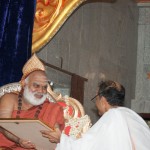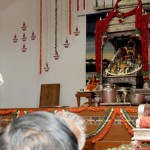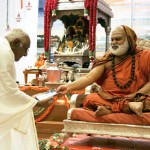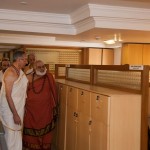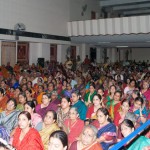
Chennai: JUNE 23-26, 2012
At Kripa Shankari Street, West Mambalam
The Jagadguru was given a grand reception at the Sringeri Shankara Math in Kripa Shankari Street, West Mambalam. At the Math, the Jagadguru first had Darshan of Lord Ratnagarbha Ganapati, Goddess Sharada, and Sri Navaneeta Krishnan. After Dhuli Pada Puja was performed by Hon. Manager Sri Ramakrishnan, the Jagadguru was offered a Swagatam in Tamil. Sri V R Gowrishankar, Administrator & CEO, spoke on the occasion mentioning how such a small Math had brought together the community on a spiritual platform.
In His Anugraha Bhashanam, the Jagadguru said that Shastras talk about “Vidhi” and “Nishedha”. “Vidhi” refers to that which something that needs to be done. “Nishedham” refers to that which something that should not be done. What needs to be done and what should not be done is decided only by the Shastras. We cannot act as we please. The Lord says the same point in the Bhagavad Gita – तस्माच्छास्त्रं प्रमाणं ते कार्याकार्यव्यवस्थितौ The Shastras are the authority for determining, what needs to be done and what has to avoided. When we mention the term “Shastras”, we only refer to the Vedas. The word “Shastram” is derived from the verse – “शास्ति इति शास्त्रम्”. Only the Vedas can assertively say what needs to be done. It is very difficult to question what is mentioned in the Vedas. The Dharma Shastras mention that Vedas are the supreme authority on Dharma in the verse – वेदोऽखिलो धर्ममूलम्. Dharma refers to something that brings us good and Vedas list down the things that bring us good and the things that we are not expected to do. We should adhere to what is mentioned in the Shastras.
The philosophers of yore have all stated – यच्छब्द आह, तदस्माकं प्रमाणम् – “Shabda” here refers to the Vedas. What the Vedas state is the authority for us. The Vedas give two instructions that apply to everyone: सत्यं वद, धर्मं चर Speak The Truth, Practice Dharma. Although these two rules look very simple, if we follow these rules religiously, welfare results not only in this birth but also in all future births. These two rules are something that all of us in the world should follow.
Even in such simple instructions, there are subtleties associated. This is because the Shastras also say, “do not utter truth if it harms someone.”, and “It is alright to tell a lie to save someone in danger.” That is why understanding the tenets of Dharma is not easy – धर्मस्य तत्त्वं निहितं गुहायाम् – Hence Dharma has to be understand from the Shastras and by the path taken and shown by Mahatmas – महाजनो येन गतः स पन्थाः – That is the path, which has been taken by a Mahatma. The Upanishads say: ये तत्र ब्राह्मणाः सम्मर्शिनः । युक्ताः आयुक्ताः । अलूक्षा धर्मकामाः स्युः । यथा ते तत्र वर्तेरन् । तथा तत्र वर्तेथाः ॥ When you cannot determine what is Dharma and Adharma, follow the behaviour of a Brahmana who is free from all desire, anger, and ever engaged in Dharma.
Once a man being pursued by soldiers came to a Rishi and sought refuge. After he was granted refuge, the soldiers came to the Ashram and enquired about him. The Rishi replied that he had not seen such a person and sent the soldiers away. Although the Rishi did not speak the truth, he saved the man’s life. If the Rishi had spoken the truth, he would have done Adharma by failing to protect the man whom he had granted refuge. Such subtleties are hidden in the Shastras where the general rule of speaking the truth is exempted. The Shastras say:
सत्यं ब्रूयात् प्रियं ब्रूयात् न ब्रूयात् सत्यमप्रियम् ।
प्रियं च नानृतं ब्रूयात् एष धर्मः सनातनः ॥
One should always speak the truth. One should always speak kind words. Do not speak truth that hurts. Do not lie for the sake of pleasing.
A man was doing his Pooja. News arrived that someone in his family had died. In this case, people in the house should not pass on this news to the man during the Pooja, eventhough its a truth. It would put him in confusion as to whether he must end the Puja abruptly or continue and finish it. The news must be passed on to the man only after he completes his Pooja.
Having given the example of the Rishi and the man in Puja to indicate that truth too must not be spoken in exceptional cases, the Jagadguru proceeded to explain why a lie must not be uttered for the sake of pleasing. There was once a student who had written an examination and had actually failed. His friend came to know about the failure. When the student enquired if he knew the result, the friend to make the student happy lied to him saying he had passed with first class. The student became very happy. However, when the student eventually realized that he had indeed failed, it not only caused him anguish but also upset him that his friend had lied.
The Jagadguru mentioned about another subtlety in Dharma. There is a rule that we should perform the morning Sandhya Vandanam before sunrise and the evening Sandhya Vandanam before sunset. But while performing Sandhya Vandanam, if your Guru happens to come, should you welcome the Guru or should you continue performing the Sandhya Vandhanam? In this instance, welcoming the Guru is a bigger Dharma than performing the Sandhya Vandanam. If you happen to ignore your Guru and continue performing the Sandhya Vandanam, the act will not have any positive effect. Welcoming and respecting the Guru is more important than anything else in the world for the Guru is given the highest status in our Dharma. He is considered a manifestation of the Trimurthis. Even a person who has taught us a single letter – “एकाक्षरप्रदाता” – is to be treated as a Guru and with great respect. Such being the case, if we end up ignoring the Guru who has taught us everything, it will be the greatest sin. Even if it means that the Sandhya Vandhanam cannot be performed at the right time, it is still excusable. This is another example of a subtlety in following Dharma.
Numerous are the illustrations given on subtleties of Dharma that can be learned from the Shruti, Smritis, Puranas, Ithihasas and also from our elders. We should practice Dharma based on what the Shastras dictate and attain prosperity in life. Knowing what is a “Vidhi” (that which needs to be done), what is a “Nishedha” (that which should not be done) should be learned only from the Shastras and not by our own experience and logic. The Jagadguru concluded His message by mentioning that all of us should understand what is Dharma and Adharma, as laid down by the Shastras, practice them and attain Shreyas.
The Jagadguru appreciated the great service being rendered by Hon. Manager of the Math, Sri. Ramakrishnan in running the Sringeri Shankara Math at Kripasankari Street, West Mambalam. On Sunday, the 24th June, tens of thousands of devotees thronged the small premises of the Math to have Darshan of the Jagadguru, perform Pada Puja and Bhiksha Vandanam. The volunteers and devotees had made such excellent arrangements even in the smallest of the Sringeri Maths in Chennai. Residents in the Kripashankari Street volunteered to aid the moving of the queue and drenched the street with water to provide relief from the hot summer sun for the devotees queued up for the Jagadguru’s Darshan. The Jagadguru blessed one and all and started from West Mambalam on June 25th and arrived at the Tattvaloka building in Eldams Road, Teynampet.
Photos
Jagadguru Graces Tattvaloka
Jagadguru Shankaracharya Sri Sri Bharati Tirtha Mahaswamiji graciously visited the Tattvaloka premises in Chennai on 25th June 2012 as part of His current visit to the city after a gap of 17 years. The Jagadguru gave Anugraha Bhashanam, performed Chandramoulisvara Puja in the Tattvaloka auditorium, stayed overnight and blessed all the staff, gave darsan to devotees, accepted bhiksha and then departed–an event that will always be etched in the memory of all associated with Tattvaloka.
Tattvaloka is Sringeri Sharada Peetham’s official monthly magazine. For those managing the Tattvaloka publication, it was the culmination of seven years of their prayers. While the staff had earnestly desired that the newly built Tattvaloka centre should be inaugurated at the hands of the Jagadguru in the year 2005, everyone was happy that the building was now consecrated with His presence. The Jagadguru was received with purnakumbham accompanied by Veda Ghosham and auspicious nadasvaram music. Immediately on alighting at the premises, all those assembled had noticed that the Jagadguru admiringly looked up at the elegant four-storey façade of the building, which in a way symbolises the growth of Tattvaloka from its modest beginnings over three decades.
The Tattvaloka administration had made elaborate arrangement for everyone to enjoy the proceedings in a happy and serene setting. The hundreds of devotees who had come from far and near to have Darshan of the Jagadguru and listen to His speech were comfortably seated in the auditorium as well as in the basement where a huge video monitor had been installed to watch the proceedings live from the hall.
After silently praying to the Sharada icon at the foyer of the building, the Jagadguru entered the auditorium, which is named as Sri Abhinava Vidyatirtha Smaraka Bhavanam in memory of His illustrious Guru. The large life-size standing portraits of both the gurus on either side of the auditorium made a perfect setting for the proceedings.
A Swagata patra in Sanskrit, read out by Brahmasri Krishnamurthy Sastrigal, former Principal of the Madras Sanskrit College, recalled the great scholarship of the Acharya and how the material appearing in every issue of Tattvaloka reflects the values cherished by the Guru.
Sri T. R. Ramachandran, Founding Editor and Publisher of Tattvaloka, and Managing Editor Smt. Sarala Panchapakesan expressed gratitude for the visit of the Jagadguru and recalled the untiring support of the Jagadguru by reviewing practically every article in the magazine in the early days, and how He continues to inspire those working in Tattvaloka as well as the thousands of readers with the benedictory message exclusively provided by Him for every issue, despite His busy schedule. The Jagadguru declared open a plaque commemorating his visit to the institution.
In His Anugraha Bhashanam on the occasion, the Jagadguru explained the significance of the word, Tattvaloka, which means “the prakasa of tattva” or “the splendour of truth”, and said the force behind the birth of the magazine was His Guru, Jagadguru Sri Abhinava Vidyatirtha Mahaswamiji, who felt the need for a magazine in English to reach a wider audience of devotees and seekers (in addition to the vernacular versions of the Shankara Krupa magazine which were catering to readers mostly in the southern states). He had felt that the English edition would help carry the splendour of Sri Sharada Peetham to the nooks and corners of the country.
The Jagadguru expressed happiness at the impressive growth of Tattvaloka reaching out to readers countrywide and globally, and attributed this to the faithful adherence to the words of the Guru (Guru vakya paripalanam) by the Editor and Publisher and all those associated with the magazine. He drew parallel to the unstinted adherence to the Guru’s command by Sureshwaracharya, the first disciple of Adi Shankara, who had initially taken the Guru’s approval to write a commentary on Brahma Sutra Bhashya but unquestioningly abided by His subsequent advice not to proceed with the writing. The Jagadguru exhorted that though everyone is engaged in some activity or the other all the time as a human being, it is necessary to perform every activity as nishkama karma (selfless service) which would indeed be a valuable step in spiritual attainment.
Melodious devotional music rendered on the keyboard by a talented youngster, K. Sathyanarayana, followed by vocal music by K. Gayathri, provided a serene backdrop to the proceedings.
Sri Chandramoulishwara Puja, performed ceremoniously by the Jagadguru at night, was witnessed by a packed hall. It was a sumptuous spiritual treat for the soul and made the hall visibly glow with an extraordinary spiritual fervour, vouched by everyone present. The premises reverberated to the chanting of Rudram and Chamakam by ritviks and devotees even as the Jagadguru was performing the puja.
On the morning of June 26, Pada Pujas and Bhikshavandanam were performed by all Tattvaloka staff members and a large number of devotees. Before leaving the premises in the evening, the Jagadguru again blessed all those present, who bade an emotional farewell to the Acharya with the fond hope that he would one day pay another visit to the Tattvaloka Centre.

